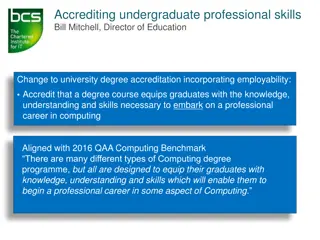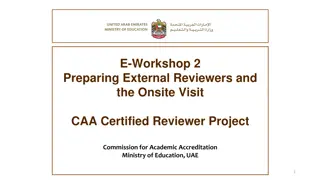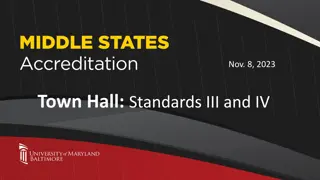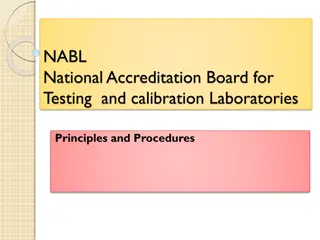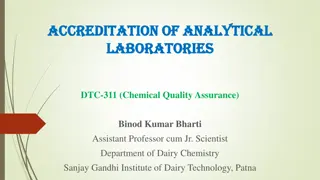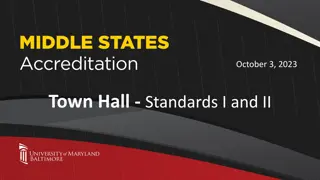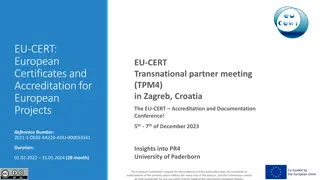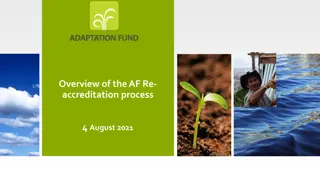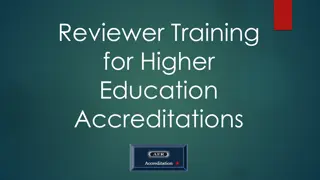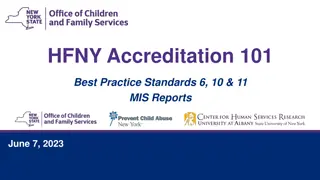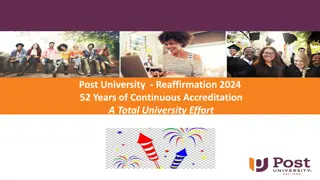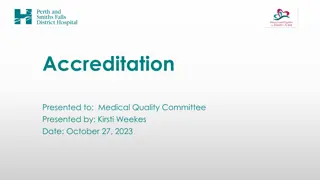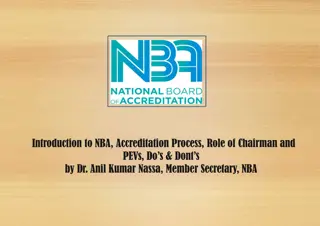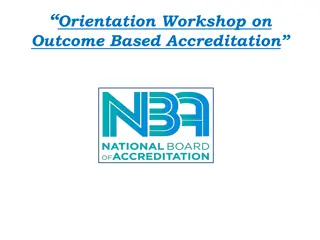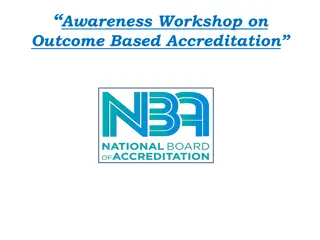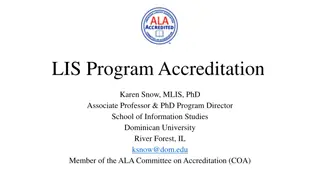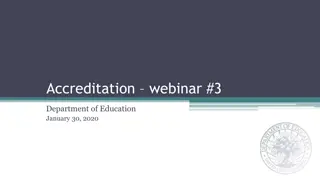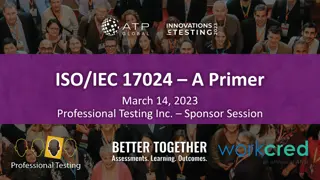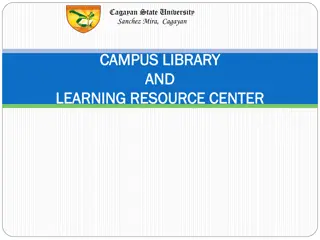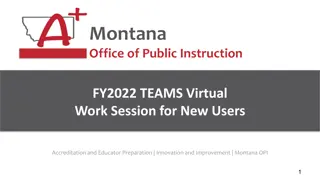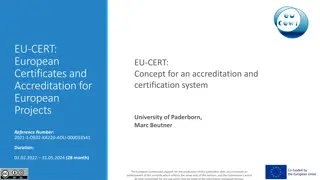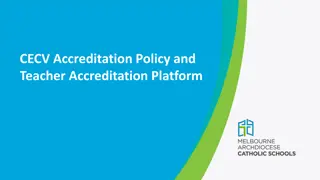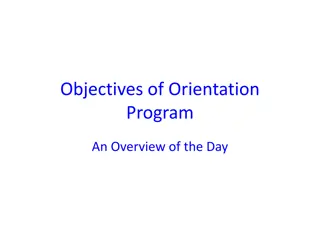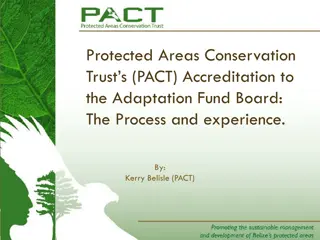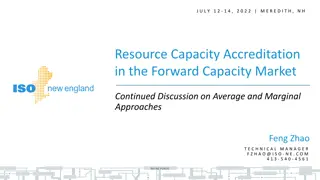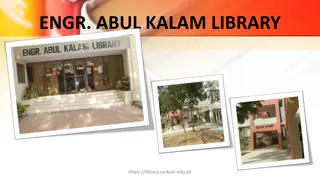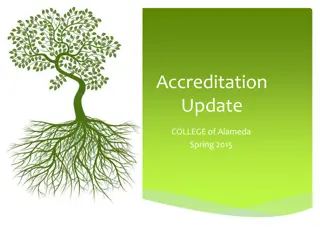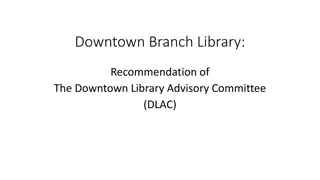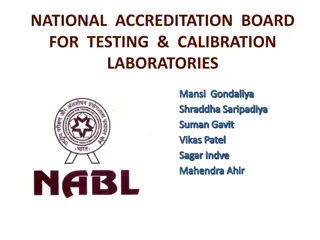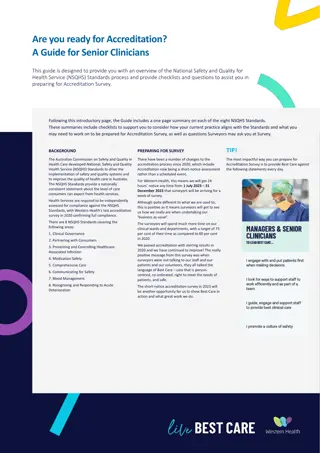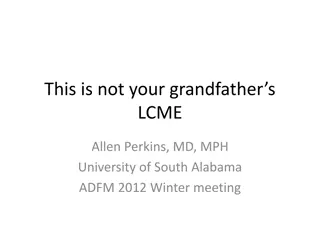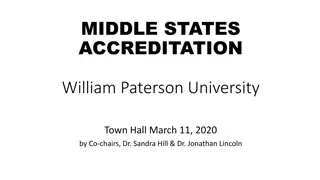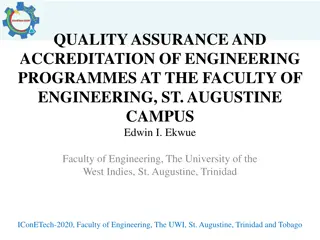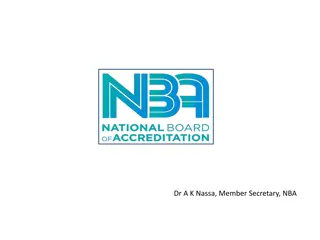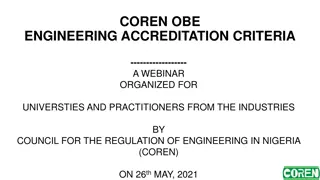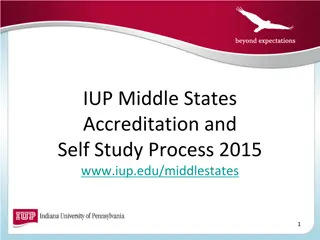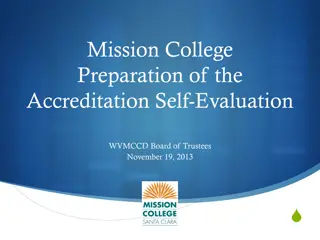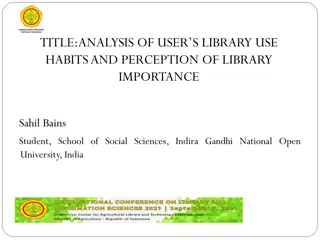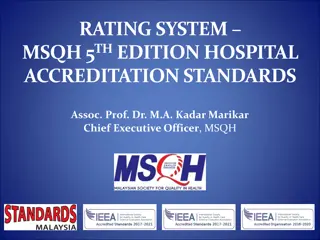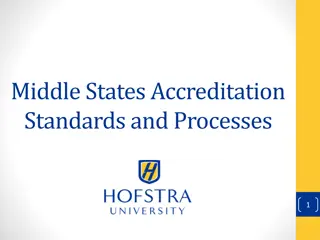Evolution of Accreditation Standards in Library and Information Studies
The shift in standards for accreditation of Master's programs in Library and Information Studies, comparing 2023 to 2015, shows a transition from 6 standards with 13 clauses to 3 standards with 3 clauses. The focus remains on systematic planning, with changes to areas such as Mission and Goals, Process, Plan, Student Learning Outcomes, Program Evaluation, and Evidence. Standard II emphasizes Program-Level Learning Outcomes and Curriculum Scope for student achievement assessment across the program.
Download Presentation

Please find below an Image/Link to download the presentation.
The content on the website is provided AS IS for your information and personal use only. It may not be sold, licensed, or shared on other websites without obtaining consent from the author. Download presentation by click this link. If you encounter any issues during the download, it is possible that the publisher has removed the file from their server.
E N D
Presentation Transcript
2023 vs 2015, Or, Where Has My Standard Gone? Standards for Accreditation of Master s Programs in Library and Information Studies American Library Association Annual Conference: Committee on Accreditation Open Meeting: June 29, 2024
Scope Standard I Systematic Planning The program s implementation of an ongoing, broad-based, systematic planning process involves the constituencies that the program seeks to serve, including members of traditionally underrepresented and historically underserved groups, and results in improvements to and innovations in the program
3 standards, with 3 subordinate clauses (2023) vs. 6 standards, with 13 subordinate clauses (2015) Standard I Systematic Planning Standard I continues to be focused on Systematic Planning Simplified to include only three areas: I.1 Mission and Goals; I.2 Process; and I.3 Plan. The elements of Systematic Planning continue to be important, but are now less restrictive to allow programs to align with unit and university systematic planning
Standard I Systematic Planning I.1 (2023) Mission and Goals I.2 (2023) Process I.3 (2023) Plan
I.1 (2015) Mission and Goals Correlates to I.1 (2023) Mission and Goals Standard I Systematic Planning I.2 (2015) Student Learning Outcomes Moved to II (2023) I.3 (2015) Program Goals & Objectives No direct correlation imbued throughout 2023 standards
I.4 (2015) Program evaluation Correlates to I.3 (2023) Plan I.5 (2015) Explicit, Documented Evidence Correlates to I.3 (2023) Plan Standard I Systematic Planning I.6 (2015) Systematic Planning Used for Program Improvement Correlates to I.2.3 (2023) Process
Standard II Program-Level Learning Outcomes and Curriculum Scope Program-level learning outcomes describe what students are expected to know and be able to do by the time of graduation. The curriculum provides descriptions of different courses of study, specializations, or other variations of study. The evaluation includes attainment of outcomes collectively across the program.
5 standards, with 0 subordinate clauses (2023) vs. 7 standards, with 6 subordinate clauses (2015) Standard II Program-Level Learning Outcomes and Curriculum Standard II continues to be focused on Curriculum Features the addition of learning outcomes, clarified to emphasize these are program level (not individual course) level outcomes Many standards have been revised, simplified, and made less redundant to allow programs more freedom in designing resilient MLIS programs for the future
II.1 (2023) Ethics and Values II.2 (2023) Program-level Learning Outcomes II.3 (2023) Curriculum II.4 (2023) Program Completion II.5 (2023) Evaluation Standard II Program-Level Learning Outcomes and Curriculum
II.1 (2015) Curriculum Goals & Objectives Correlates to II.1 (2023) Ethics & Values Standard II Program-Level Learning Outcomes and Curriculum II.2 (2015) Information Resources, Services, and Technologies Correlates to II.2 (2023) Program-level Learning Outcomes II.3 (2015) Coherent Programs of Study Coherent programs of study correlates to II.4 (2023) Program Completion Other curriculum requirements correlate to II.2 (2023) Program-level Learning Outcomes
II.4 (2015) General and Specialized Curricula Design Correlates to II.2 (2023) Program-level Learning Outcomes Standard II Program-Level Learning Outcomes and Curriculum II.5 (2015) Continual Evaluation Correlates to II.5 (2023) Evaluation II.6 (2015) Documented Evidence Correlates to II.5 (2023) Evaluation II.7 (2015) Demonstration of Evidence Use in Planning Correlates to II.5 (2023) Evaluation
Scope Standard III Faculty The faculty are diverse in representation and have the necessary qualifications, achievements, and resources to support the program. Faculty performance is regularly evaluated by criteria relevant to the program
6 standards (2023) vs. 10 standards (2015) Standard III Faculty Standard III continues to be focused on Faculty Less prescriptive, giving programs more flexibility to hire faculty to meet program needs and strengthening attention on diversity Elements of Standard V (2015) regarding compensation and other supports have been moved to Standard III (2023)
III.1 (2023) Faculty Diversity III.2 (2023) Program Faculty III.3 (2023) Faculty Qualifications Standard III Faculty III.4 (2023) Faculty Workload III.5 (2023) Faculty Support III.6 (2023) Faculty Evaluation and Development
III.1 (2015) Capable of Achieving Program Objectives Correlates to III.2 (2023) Program Faculty Standard III Faculty III.2 (2015) Teaching, Research, and Service No direct correlation imbued throughout III (2023) III.3 (2015) Recruitment and Retention Correlates to III.1 (2023) Faculty Diversity
III.4 (2015) Qualifications Correlates to III.3 (2023) Faculty Qualifications III.5 (2015) Research and Scholarship Correlates to III.3 (2023) Faculty Qualifications Standard III Faculty III.6 (2015) Diversity of Backgrounds and Academic Study Correlates to III.3 (2023) Faculty Qualifications III.7 (2015) Faculty Assignments Correlates to III.4 (2023) Faculty Workload
III.8 (2015) Systematic Evaluation of Faculty Correlates to III.6 (2023) Faculty Evaluation & Development III.9 (2015) Documented Evidence of Evaluation Correlates to III.6 (2023) Faculty Evaluation & Development Standard III Faculty III.10 (2015) Evaluation Used for Program Improvement Correlates to III.6 (2023) Faculty Evaluation & Development
Scope Standard IV Students The program has processes and systems to recruit, retain, and support students and prospective students, as well as the evaluation and continuous improvement of those processes and systems
3 standards, with 0 subordinate clauses (2023) vs. 8 standards, with 6 subordinate clauses (2015) Standard IV Students Standard IV continues to be focused on Students Student health & safety has been added Some elements, notably student plan of study, moved to II (2023) Curriculum
IV.1 (2023) Student Diversity IV.2 (2023) Public Information IV.3 (2023) Student Qualifications IV.4 (2023) Student Advising, Services, and Support IV.5 (2023) Student Engagement IV.6 (2023) Evaluation Standard IV Students
IV.1 (2015) Recruitment, Retention, Admission, Academic, Aid Policies Correlates to IV.3 (2023) Student Qualifications IV.2 (2015) Current, Accurate Program Information Correlates to IV.2 (2023) Public Information Standard IV Students IV.3 (2015) Admission Standards Applied Consistently Correlates to IV.3 (2023) Student Qualifications IV.4 (2015) Coherent Plan of Study Correlates to IV.4 (2023) Student Advising, Services, and Support AND II.4 (2023) Program Completion
IV.5 (2015) Student Participation Correlates to IV.4 (2023) Student Advising, Services, and Support IV.6 (2015) Student Achievement Informs Program Planning Correlates to IV.6 (2023) Evaluation Standard IV Students IV.7 (2015) Documented Evidence of Planning Using Student Outcomes Correlates to IV.6 (2023) Evaluation IV.8 (2015) Systematic Improvement Using Student Outcomes Correlates to II.2 (2023) Program-level Learning Outcomes AND II.5 (2023) Evaluation
Scope Standard V Infrastructure Programs have the administrative, financial, physical, and technological resources and services to support student learning and enable program-level learning outcomes to be achieved. Programs evaluate these resources and services for continuous improvement
6 standards (2023) vs. 15 standards (2015) Standard V was previously described as Administration, Finances, and Resources Focus remains the same Made more explicit and concise Changes reflect the ongoing incorporation and nature of online programs Some elements, such as those regarding faculty compensation and adjuncts, were moved to III (2023) Faculty v
V.1 (2023) Values Underlying Infrastructure V.2 (2023) Autonomy and Administrative Infrastructure V.3 (2023) Participation V.4 (2023) Administrative Support V.5 (2023) Physical, Technological, and Information Resources V.6 (2023) Evaluation Standard V Infrastructure
V.1 (2015) Distinct Academic Unit Correlates to V.2 (2023) Autonomy and Administrative Infrastructure V.2 (2015) Representation on Institutional Bodies Correlates to V.3 (2023) Participation Standard V Infrastructure V.3 (2015) Authority of Administrative Head Correlates to V.2 (2023) Autonomy and Administrative Infrastructure V.4 (2015) Environment Correlates to V.1 (2023) Values AND V.2 (2023) Autonomy and Administrative Infrastructure
V.5 (2015) Fulfillment of Mission, Goals, and Objectives Correlates to V.4 (2023) Administrative Support AND V.2 (2023) Autonomy and Administrative Infrastructure V.6 (2015) Parent Institution Support Correlates to V.5 (2023) Physical, Technological, and Information Resources Standard V Infrastructure V.7 (2015) Compensation Correlates to III.5 (2023) Faculty Support V.8 (2015) Institutional Parity for Faculty and Students Correlates to III.5 (2023) Faculty Support AND IV.4 (2023) Student Advising, Services, and Support
V.9 (2015) Access to Physical and Technological Resources Correlates to V.5 (2023) Physical, Technological, and Information Resources V.10 (2015) Functional Learning Environments Correlates to V.5 (2023) Physical, Technological, and Information Resources Standard V Infrastructure V.11 (2015) Instructional and Research Facilities Correlates to V.5 (2023) Physical, Technological, and Information Resources V.12 (2015) Institutional Libraries, IT, and Other Support Facilities Correlates to V.5 (2023) Physical, Technological, and Information Resources
V.13 (2015) Administrative Resources and Systematic Planning Correlates to V.6 (2023) Evaluation V.14 (2015) Documented Evidence of Administrative Systematic Planning Correlates to V.6 (2023) Evaluation Standard V Infrastructure V.15 (2015) Program Improvement Through Administrative Systematic Planning Correlates to V.6 (2023) Evaluation


